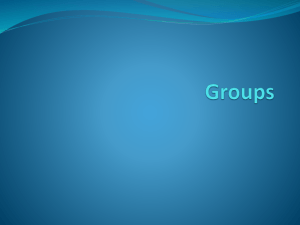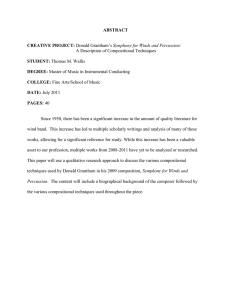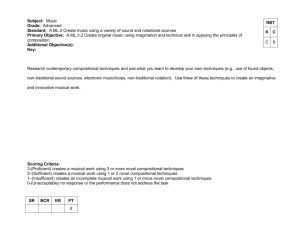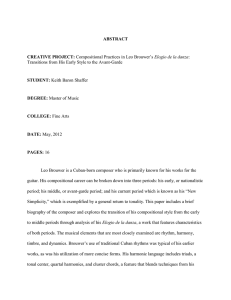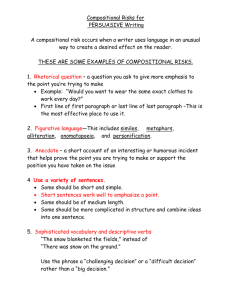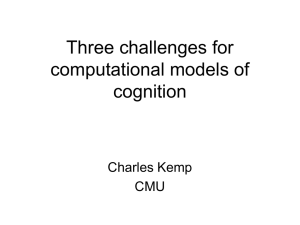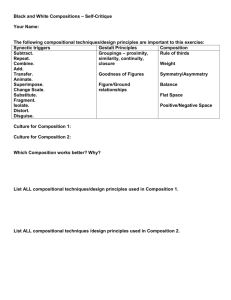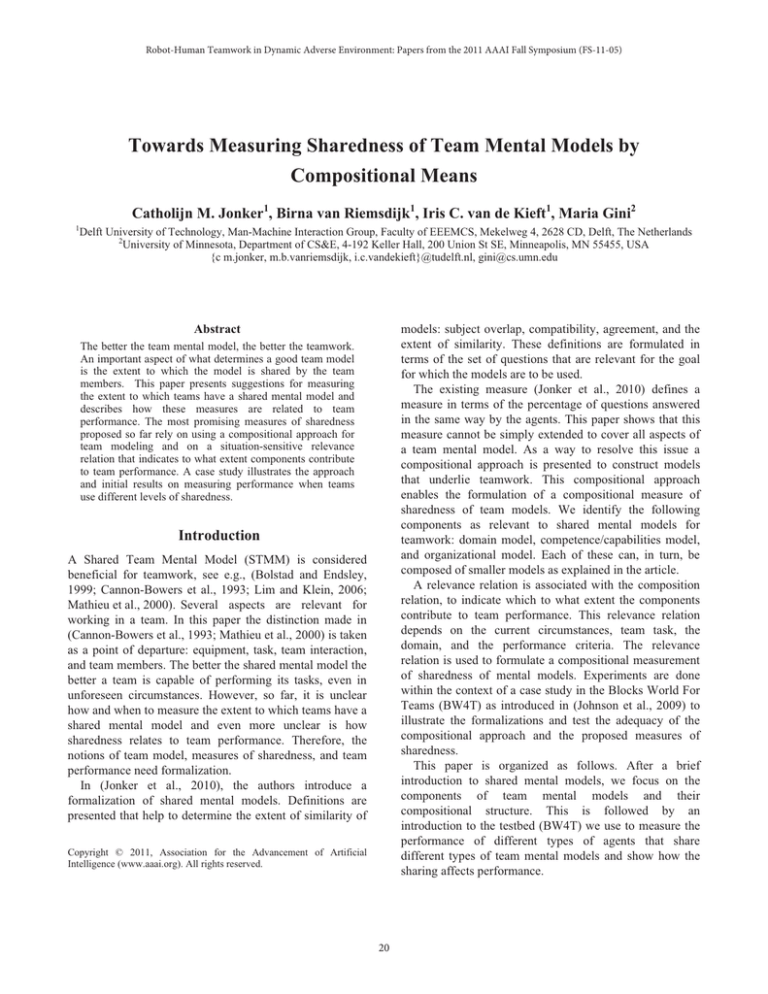
Robot-Human Teamwork in Dynamic Adverse Environment: Papers from the 2011 AAAI Fall Symposium (FS-11-05)
Towards Measuring Sharedness of Team Mental Models by
Compositional Means
Catholijn M. Jonker1, Birna van Riemsdijk1, Iris C. van de Kieft1, Maria Gini2
1
Delft University of Technology, Man-Machine Interaction Group, Faculty of EEEMCS, Mekelweg 4, 2628 CD, Delft, The Netherlands
2
University of Minnesota, Department of CS&E, 4-192 Keller Hall, 200 Union St SE, Minneapolis, MN 55455, USA
{c m.jonker, m.b.vanriemsdijk, i.c.vandekieft}@tudelft.nl, gini@cs.umn.edu
models: subject overlap, compatibility, agreement, and the
extent of similarity. These definitions are formulated in
terms of the set of questions that are relevant for the goal
for which the models are to be used.
The existing measure (Jonker et al., 2010) defines a
measure in terms of the percentage of questions answered
in the same way by the agents. This paper shows that this
measure cannot be simply extended to cover all aspects of
a team mental model. As a way to resolve this issue a
compositional approach is presented to construct models
that underlie teamwork. This compositional approach
enables the formulation of a compositional measure of
sharedness of team models. We identify the following
components as relevant to shared mental models for
teamwork: domain model, competence/capabilities model,
and organizational model. Each of these can, in turn, be
composed of smaller models as explained in the article.
A relevance relation is associated with the composition
relation, to indicate which to what extent the components
contribute to team performance. This relevance relation
depends on the current circumstances, team task, the
domain, and the performance criteria. The relevance
relation is used to formulate a compositional measurement
of sharedness of mental models. Experiments are done
within the context of a case study in the Blocks World For
Teams (BW4T) as introduced in (Johnson et al., 2009) to
illustrate the formalizations and test the adequacy of the
compositional approach and the proposed measures of
sharedness.
This paper is organized as follows. After a brief
introduction to shared mental models, we focus on the
components of team mental models and their
compositional structure. This is followed by an
introduction to the testbed (BW4T) we use to measure the
performance of different types of agents that share
different types of team mental models and show how the
sharing affects performance.
Abstract
The better the team mental model, the better the teamwork.
An important aspect of what determines a good team model
is the extent to which the model is shared by the team
members. This paper presents suggestions for measuring
the extent to which teams have a shared mental model and
describes how these measures are related to team
performance. The most promising measures of sharedness
proposed so far rely on using a compositional approach for
team modeling and on a situation-sensitive relevance
relation that indicates to what extent components contribute
to team performance. A case study illustrates the approach
and initial results on measuring performance when teams
use different levels of sharedness.
Introduction
A Shared Team Mental Model (STMM) is considered
beneficial for teamwork, see e.g., (Bolstad and Endsley,
1999; Cannon-Bowers et al., 1993; Lim and Klein, 2006;
Mathieu et al., 2000). Several aspects are relevant for
working in a team. In this paper the distinction made in
(Cannon-Bowers et al., 1993; Mathieu et al., 2000) is taken
as a point of departure: equipment, task, team interaction,
and team members. The better the shared mental model the
better a team is capable of performing its tasks, even in
unforeseen circumstances. However, so far, it is unclear
how and when to measure the extent to which teams have a
shared mental model and even more unclear is how
sharedness relates to team performance. Therefore, the
notions of team model, measures of sharedness, and team
performance need formalization.
In (Jonker et al., 2010), the authors introduce a
formalization of shared mental models. Definitions are
presented that help to determine the extent of similarity of
Copyright © 2011, Association for the Advancement of Artificial
Intelligence (www.aaai.org). All rights reserved.
20
ground model. If not, then in the definitions dividing by the
number of relevant questions causes problems.
Shared Mental Model
Team Mental Models
The measure of sharedness of (Jonker et al., 2010) is
defined in terms of a definition of model subject overlap
and a definition of model agreement.
Subject overlap provides a measure for the extent to which
models provide answers to the set of relevant questions Q.
These answers may be different, but at least an answer
should be given (“unknown” is not considered to be an
answer). For example, posing a question about bicycles to
a model of birds would typically not yield an answer. Also,
answers are assumed to be individually consistent.
Team models should at least distinguish equipment, task,
team interaction, and team members (Cannon-Bowers et
al., 1993; Mathieu et al., 2000). This section adds some
components, and then discusses possible compositional
structures of team mental models in relation to the
influence of the situation on the relevance of the
components for team performance.
Components of Team Mental Models
Equipment, task, team interaction, and team members
should be part of the team mental model according to
(Cannon-Bowers et al., 1993; Mathieu et al., 2000). This
paper proposes a restructure of the team mental model and
to add information and knowledge about the domain
(world and agents), and to add the underlying ontologies
for the whole team mental model as elements of the team
mental model. The usual components that refer to task,
team interaction, and team members will be part of the
organizational specification.
Ontologies: referring to the domain ontology and
ontologies for all parts of the domain model as described
below.
World state model: the relevant aspects of the world state
should be known to the team members, and thus part of the
team mental model. This part of the model also contains
knowledge that would improve performance if shared, e.g.,
strategies and/or procedures useful for this domain / task.
For hunting teams, one could think of exploration patterns
and hunting strategies.
Agent models: what are the relevant agents in the domain,
what does the one that has the agent models know about
the capabilities of agents. Furthermore, a related concept,
but still different: the model should describe to what extent
agents are competent with respect to their capabilities. For
example, there is a difference between the capability of
retrieving a block and the competence in retrieving, e.g.,
one agent can retrieve much faster than another agent. The
next sections show that sharing information about the
intentions of team members (and even non-team member
agents) can contribute significantly to team performance.
The same holds for information about their personalities,
preferences, and habits.
Organizational specification: contains the models about
task, team members, and team interaction. We refer to
existing methods to specify organizations, such as MOISE
(Hübner et al., 2002), OperA (Dignum, V., 2003), AGR
(Ferber and Gutknecht, 1998). Regarding team members,
the model should describe which agents are team members,
Definition 1 Model Subject Overlap (Jonker et al., 2010).
Let the set of questions for which the models provide
answers (not necessarily similar answers) be
OverAns(M1,M2,Q) = {q אQ | a1, a2 : M1 |- answer(a1,
q) and M2 |- answer(a2, q)}. The level of subject overlap
between the model M1 and M2 with respect to set of
questions Q is defined as
SO(M1,M2,Q) = |OverAns(M1,M2,Q) | / |Q|.
Model agreement defines the extent to which models
provide equivalent answers to questions. In the definition T
refers to a background theory used for interpreting
answers, and Ł T stands for equivalence with respect to T.
For example, the answers “1 meter” and “100 centimeter”
are equivalent with respect to the usual definitions of units
of length.
Definition 2 Model agreement (Jonker et al., 2010). Let
the set of questions for which the models agree be
AgrAns(M1,M2,Q) = {q אQ | a1, a2 : M1 |- answer(a1,
q) and M2 |- answer(a2, q) and a1Ł T a2}. Then, the level
of agreement between the model M1 and M2 with respect
to set of questions Q is defined as:
A(M1,M2,Q) = |AgrAns(M1,M2,Q) | / |Q|.
Definition 3 Shared Mental Model (Jonker et al., 2010). A
model M is a mental model that is shared to the extenWșE\
agents A1 and A2 with respect to a set of questions Q iff
there is a mental model M1 of A1 and M2 of A2, both with
respect to Q, such that
1. SO(M,M1,Q) = 1, and SO(M,M2,Q) = 1
2. A(M,M1,Q) șDQG$004ș
In the remainder of the paper Definition 3 is used to
determine the sharedness of models. However, what should
be part of the team mental model and should be shared is
described in the next section. In order for the definitions to
work, it is assumed that the model corresponds to a finite
21
task performed, how was the interaction amongst team
members (atmosphere, team spirit, amount of
communication needed). Furthermore, in case of repetitive
tasks, one might consider changes in performance with
respect to previous times the task was performed. How
well is the team capable of dealing with unexpected events
(robustness)?
As the aim of this paper is to show that the predictive
power of sharedness measures for team performance is
situation dependent, not all possible aspects of team
performance need to be considered, and the same holds for
team model components. Therefore, in the experiments
discussed in the remainder of this paper, only time to finish
the task is taken as the measure for team performance.
Similarly, the team mental model is reduced to world state
and intention state.
and what role the agents play in the team. The role
specifications will refer to the role behavior and the
relevant capabilities and competences for that role. To
describe capabilities and competences use is made of the
ontologies for the domain related to tasks and world state
elements. The team task is also part of the organizational
specification: it specifies when a task is finished
successfully. The team interaction refers to the expected
and allowed communications and the timing thereof. Team
interaction further refers to e.g., rules of engagement,
doctrine, norms, and role interaction. The organizational
specification might also indicate which submodels need to
be shared, and which need not to be shared. An example in
BW4T is two agents A and B having different roles, A
retrieves the blue blocks, B the red ones. The agents need
not have a fully shared mental model of the location of the
blue and red blocks.
Compositional Structures and Relevance
The Team Member Agents Tested in BW4T
Not in all situations all possible components of team
mental models are relevant for team performance. For
example, the agents described in the next section don’t
have the capability to reason about capabilities of
themselves or other agents. As a result requiring the agents
to have a shared mental model about these competences
will not improve performance.
Different hierarchical composition relations can be
constructed that respect to the previous section. The point
that this paper would like to make is that a hierarchical
composition relation is more transparent than having one
big unstructured model.
Note that the compositional structure of the model can
be reflected in a compositional structure of the set of
questions Q, e.g., the subset of questions on the current
situation (domain model), the subset of questions on the
organizational specification. Note that if there is no
organizational specification from the start, then the team
members have to determine their organizational structure
for themselves. For this the agents can use communication
on the topics normally addressed in organizational
specifications.
Figure 1: Abstract Decision Cycle of the Agents
To measure team performance under different levels of
sharedness, agents were constructed in GOAL (Hindriks,
2009) for the relatively simple BW4T domain (Johnson et
al., 2009). BW4T is an extension of the classic blocks
world that is used to research joint activity of teams in a
controlled manner. A team of agents has to deliver colored
blocks from a number of rooms to the so-called drop zone
in a certain color sequence. The agents can communicate
with each other but their visual range is rather limited.
They can see where they are in the world, but they can
Team Performance
To measure team performance requires performance
criteria. Criteria typically used are: how long did it take to
complete the task, to what extent was the task successfully
completed (quality), and the way the task was performed.
This last category can encompass a variety of elements,
such as, did the team work have unintended and / or
unexpected side effects, under what circumstances was the
22
only see objects not other agents. Furthermore, objects can
only be seen by agents that occupy the room that the
objects are in. That means that if an agent drops a block in
the hall ways, then this block is lost to all agents. Finally,
the world restricts access to rooms to one agent at a time.
In the version of the BW4T used in this paper,
communication and sensing can be assumed to be reliable,
and the world is only changed by the actions of the agents.
Room_C2: box_20, box_19.
Room_C3: box_21, box_22.
In the second scenario, the task sequence was [red,
white, yellow, darkBlue, orange, lightGreen].
The agent programming to solve the BW4T tasks was
based on the decision cycle presented in Figure 1. Note
that the aim was not to produce the most efficient agent for
this problem, but agents useful for measuring how different
levels of sharedness affect team performance and the effect
of using a compositional team model versus a flat team
model. Futhermore, agents and example domain should be
both simple and rich enough to demonstrate the impact of
the set of questions Q underlying the team model.
Therefore, the following choices were made.
One template agent was modeled, that, in principle, can
solve the task alone. The agents spawned from this
template are telling the truth and believe everything they
are told. Agent capabilities were left out of consideration in
the modeling of the agent, and out of the team models.
Four homogeneous teams were formed using copies of the
template agent.
Team A consisted of agents that do not communicate at
all. The agents in Team B communicate only world
information to each other. Team C agents only
communicate their intentions to each other. Finally, the
agents in team D communicate world information and
intentions to each other. Each team consisted of three
agents, called Bot0, Bot1, and Bot2. This fact was known
to all agents, in all teams, in all scenarios. The decision
cycle for dealing with the BW4T environment is depicted
in Figure 1. To give an idea of how the GOAL code of the
agents looks, we include here some examples of action
rules for processing world information. The first rule
processes the percept of a block of a certain color, by
inserting this information into the agent's belief base and
communicating it to the other agents. The second rule
processes the corresponding message by inserting the
content into the belief base. The third rule adopts a goal of
holding a block and sends the information about this
intention to the other agents. The last rule processes
messages concerning the intention of another agent to
deliver a block.
Figure 2: Snapshot of the BW4T environment
We consider two scenarios: one with two color
repetitions (called medium), and another one with a target
sequence of six unique colors (called high). Both scenarios
are executed in the same environment consisting of 3 rows
of 3 rooms each (A1, A2, A3, B1, B2, B3, C1, C2, C3)
connected by corridors. In each scenario, 22 blocks
(box_1, … box_22) of various colors were placed in the
different rooms.
In the first scenario, the task was to bring blocks to the
drop zone according to the following sequence: [red, white,
white, yellow, darkBlue, darkBlue]. The relevant available
blocks and their colors and locations are specified by the
following:
DarkBlue: box_8, box_14.
Red: box_4.
% If Block of Color is perceived, insert in belief base and send to others
forall bel(percept(color(Block,Color))) do
insert(color(Block,Color)) + send(allother, :color(Block,Color)) .
White: box_11, box_19.
Yellow: box_9.
% received messages are inserted in belief base and message deleted
forall bel(received(Sender, color(Block,Color))) do
insert(color(Block,Color)) + delete(received(Sender, color(Block,Color))).
Room_A1: box_2, box_3.
Room_A2: box_1, box_4, Box_8, box_9.
Room_A3: box_5, box_6, box_7.
% macro used as abbreviation of condition expressing which block has the
% color to be delivered next in sequence
#define nextColorLocKnown(Block)
bel(nextColorToDeliver(Color), color(Block, Color), at(Block,Location)).
Room_B1: box_10.
Room_B2: box_13, box_12, box_11.
Room_B3: box_16, box_14, box_15.
Room_C1: box_18, box_17.
23
% If I know where a block of the next color to be delivered is, and I don't
%already have the goal of holding a block and I'm not already holding a
%block, then adopt the goal of holding the block and send this intention to
%others
if nextColorLocKnown(Block), not(a-goal(holding(Block2))),
bel(color(Block, Color), not(in('Drop_Zone')), not(holding(_)))
then adopt(holding(Block)) + send(allother, !deliver(Block, Color)).
The performance of the different teams in the two
scenarios is depicted in Figure 3. The figure shows for
each team and scenario the time at which each block in the
% If a message is received that another agent wants to deliver a Block of
%Color, insert this in belief base and delete the message
forall bel(received(Sender, imp(deliver(Block, Color))))
do insert(imp(Sender, deliver(Sender, Block, Color)))
+ delete(received(Sender, imp(deliver(Block, Color)))).
Pilot Experiment: First Results
In this section we discuss first results on the experiment
that we are conducting in order to determine the
relationship between different measures of sharedness and
team performance.
As discussed earlier, to be able to determine the relation
of sharedness to performance the sharedness of the various
components of the team model has to be considered at
various time points while the team is at work. As observed
in (Jehn and Mannix, 2001) changes that happen over time
while the team is at work affect team performance.
The following timing options were considered: after
each observation by some agent, after each communication
by some agent, and after each block delivery. Measuring
after each communication leads to a weak increase in
sharedness (at least of some component). As agents of
different teams have various communication strategies,
measuring sharedness after each communication would
make the measures hard to compare; in some teams no
measurements would be taken, in some teams many
measurements would be taken.
Measuring after each observation leads to a change in
sharedness of the world component of the team model: a
decrease if an agent observes something that no other agent
has observed before without telling the others, and an
increase if this is the last agent to learn of the facts it
observed. As this depends on the communication strategy
of the agents in the different teams, measuring sharedness
after each observation would also make the measures hard
to compare.
Measuring after each block delivery would provide the
same number of measurements in all the teams (if the
teams are successful). Furthermore, the number of
measurements is limited to the length of the sequence of
colors to be delivered. Therefore, we decided to measure
sharedness of the mental models of the agents after every
block delivery.
In the following, we present initial results of the
experiment with respect to team performance and amount
of communication between team members. In future work,
we will relate these results to other measures of sharedness.
Figure 3: Performance: time to complete the team task
goal sequence was delivered. We can thus observe that the
performance of team D (full communication) was the best,
and there is not much difference between the two
scenarios.
The results for team C are not depicted, but these are
comparable to team B. This means that communicating
world information and communicating intentions seem to
have a similar effect on team performance. Also the effect
of not communicating certain information seems to have a
greater effect in the high scenario, i.e., the one with
different colored blocks. This may be due to the fact that if
two agents go for the same color due to lack of
communication, this is more of a problem if there are no
double colors in the goal sequence. If there are, it may still
be useful to collect blocks of the same color. Also one can
see that the difference in performance between team A (no
communication) and teams B and C (either world
information or intentions are communicated) is not very
large. Only in case of full communication we can see a
significant gain in performance.
Figure 4 depicts the amount of communication in the
different teams and scenarios. Team A had no
communications at all. We can see that the amount of
communication is highest in team D, as is to be expected,
but the difference with team B (world information) is
small. This means that the performance gain from
communication is relatively large for communication of
only intentions, in comparison with communication of only
world information. The communication of team C
(intentions only) has the smallest communication
24
requirements yet it produces a performance, shown in
Figure 3, which is similar to that obtained by team B
(world information) at a much smaller cost.
References
Bolstad, C., and Endsley. M., 1999. Shared mental models and
shared displays: An empirical evaluation of team performance.
Human Factors and Ergonomics Society Annual Meeting
Proceedings, 43(3):213–217.
Cannon-Bowers, J. A., Salas, E., and, Converse, S., 1993. Shared
mental models in expert team decision making. In: N. J.
Castellan, editor, Individual and group decision making,
Lawrence Erlbaum Associates, pp. 221–245.
Dignum, V., 2003. A model for organizational interaction: based
on agents, founded in logic. Dissertation, Universiteit Utrecht.
Ferber, J., and, Gutknecht, O., 1998. A meta-model for the
analysis and design of organisations in multi-agent systems. In:
Proceedings of the Third International Conference on MultiAgent Systems (ICMAS’98), IEEE Computer Society Press, pp.
128-135.
Hindriks, K. V., 2009. Programming rational agents in GOAL. In
R. H. Bordini,M. Dastani, J. Dix, and A. El Fallah Seghrouchni,
(eds.), Multi-Agent Programming: Languages, Tools and
Applications. Springer, Berlin, pp. 119-157.
Hübner, J.F., Sichman, J.S., and, Boissier, O., 2002. A model for
the structural, functional, and deontic specification of
organizations in multiagent systems. In: Advances in Artificial
Intelligence, 16th Brazilian Symposium on Artificial Intelligence,
(SBIA’02), volume 2507 of LNCS, Springer, pp. 118–128.
Jehn, K.A., and Mannix, E. A., 2001. The dynamic nature of
conflict: a longitudinal study of intragroup conflict and group
performance. The Academy of Management Journal, 44(2):238–
251.
Johnson, M., Jonker, C.M., Riemsdijk, M. B. van, Feltovich, P.J.,
and, Bradshaw, J.M., 2009. Joint activity testbed: Blocks world
for teams (BW4T). In: Proceedings of the Tenth International
Workshop on Engineering Societies in the Agents’ World
(ESAW’09), volume 5881 of LNAI, Springer. pp. 254–256.
Jonker, C.M., Riemsdijk, M.B. van, and, Vermeulen, B., 2010.
Shared Mental Models: A Conceptual Analysis. In: Proceedings
of the 9th International Workshop on Coordination,
Organization, Institutions and Norms in Multi-Agent Systems,
COIN@AAMAS2010, Springer LNCS series, to appear.
Lim, B., and, Klein, K., 2006. Team mental models and team
performance: A ¿HOG VWXG\ RI WKH HIIHFWV RI WHDP PHQWDO PRGHO
similarity and accuracy. Journal of Organizational Behavior,
27(4):403.
Mathieu, E., Heffner, T. S., Goodwin, G., Salas, E., and, CannonBowers, J., 2000. The inÀXHQFHRIVKDUHGPHQWDOPRGHOVRQWHDP
process and performance. Journal of Applied Psychology,85(2):
273–283.
Figure 4: Communication overhead
Conclusions
In this paper we have presented some criteria for
measuring sharedness of Team Mental Models. Properties
of the criteria are that they are compositional, situation
dependent, constrained, and avoid an infinity of terms in
the questions / answers used to measure sharedness.
We have also presented results of initial experiments
where we compared different types of simulated agents in
the domain of the BW4T. The main assumption made is
that agents can solve the task individually. Since the
objective of the experiment was to measure if and how
sharing mental models improves performance, agents do
not need to be sophisticated or to use an optimal strategy.
The domain, task, and team members are given up front
and are relatively simple to enable assessing improvements
without excessive complexity. For the same reasons,
sensing and actions are assumed to be correct. The results
show that the amount of sharedness affects team
performance.
Future work will focus on additional performance
measures, using more sophisticated agents capable of
reasoning about their team mates and including errors in
sensing and actions. More general questions will also be
addressed, such as how the compositional structure of the
model can be reflected in a compositional structure of the
set of questions used to measure sharedness.
25

